
Alappuzha District Map Click here to view
District Head Quarters : Alappuzha,
Area 1,414 Sq Km,
Population21,05,349,
Literacy 93.66%
Geographical hints: - Alappuzha district was formed on August 17, 1957 . The total area of the district comprises midland and seashore between the Arabian Sea and the Vembanattu Kayal. 82 Km Seashore which is the 13.9% of the State's total seashore. Pamba, Manimala Achenkovil which merge with Pamba. There is no forest land in the district.
Washed by the silvery waves of the Arabian sea Alappuzha occupies a significant place in the tourist map of Kerala. Interlocked with a large number of canals and bridges this water locked district has immense untapped potential for backwater tourism.
Alappuzha has several canals and lakes fit for boat cruise. Three prominent rivers in the southern grid of Kerala viz. Achankovil, Pamba and Manimala empty into the lakes. A boat journey through the lakes will be a memorable experience. The watercourses are flanked by an unending row of coconut trees which heave and sway to the tune of the gush.
Alleppey the beach here is spectacular .At one end are the dense palm groves that are so characteristic of Kerala's landscape. You can cut across the sea waves lashing the shore in passionate fury, or indulge in the luxury of sitting on a sand dune and paddling your feet in the water

Alappuzha Beach is a beach in Alappuzha town and a tourist attraction in Kerala, India.Beach has an old pier which extend to sea is over 150 years old.Alappuzha beach host many events annually like Alappuzha beach festival,Sand art festival and many more.Alappuzha beach is one of the major tourist spot in Alappuzha town. Alappuzha Lighthouse situated near to the beach.Beach is accessible through various town roads and an elevated highway will passing by the beach as part of Alappuzha bypass in order to preserve the beauty of the area.Camel safaris was another attraction in beach which introduced a couple of years ago but it got banned by authorities.Alappuzha beach festival is a famous event organised as part of new year celebration. It's organised as an annual event in every year. Thousands of people gathers in the event includes from other district.Kerala's first international sand art festival and competition held on April 26-2015 in Alappuzha beach. Many national and international sand artists participated in event. The state tourism department and the Alleppey Foundation has jointly organised the event.
Nehru Trophy Boat Race, the annual water carnival at Punnamada Lake, is considered the biggest snake boat race in the world. The colourful boat pageantry which precedes the boat race is a marvellous treat to the eyes. The snakeboats with a length of 30 to 60 metres and with 100 to 150 oarsmen plough the waters with the rhythm and symbols to the tune of the legendary songs.
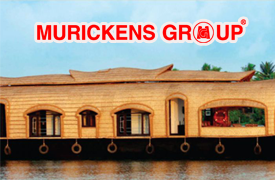 The Nehru Trophy was instituted by the late Prime Minister Jawaharlal Nehru who was enthralled by the charm and gaiety of the water carnival. The boat race attracts a large number of tourists, domestic and foreign.The Kerala backwaters are a network of brackish lagoons and lakes lying parallel to the Arabian Sea coast (known as the Malabar Coast) of Kerala state in southern India, as well as interconnected canals, rivers, and inlets, a labyrinthine system formed by more than 900 kilometres (560 mi) of waterways, and sometimes compared to American bayous.The network includes five large lakes linked by canals, both man made and natural, fed by 38 rivers, and extending virtually half the length of Kerala state. The backwaters were formed by the action of waves and shore currents creating low barrier islands across the mouths of the many rivers flowing down from the Western Ghats range. In the midst of this landscape there are a number of towns and cities, which serve as the starting and end points of backwater cruises.
The Nehru Trophy was instituted by the late Prime Minister Jawaharlal Nehru who was enthralled by the charm and gaiety of the water carnival. The boat race attracts a large number of tourists, domestic and foreign.The Kerala backwaters are a network of brackish lagoons and lakes lying parallel to the Arabian Sea coast (known as the Malabar Coast) of Kerala state in southern India, as well as interconnected canals, rivers, and inlets, a labyrinthine system formed by more than 900 kilometres (560 mi) of waterways, and sometimes compared to American bayous.The network includes five large lakes linked by canals, both man made and natural, fed by 38 rivers, and extending virtually half the length of Kerala state. The backwaters were formed by the action of waves and shore currents creating low barrier islands across the mouths of the many rivers flowing down from the Western Ghats range. In the midst of this landscape there are a number of towns and cities, which serve as the starting and end points of backwater cruises.
In addition to this the boat races at Payippad, Thiruvanvandoor, Neerettupuram, Karuvatta and Thykkoottam are quite famous.
Alappuzha is a great centre of fisheries. 'Chakara' a rare marine phenomenon in which a large number of fish throng together in the early days of May to August is a peculiarity of Purakkad, one of the main fishing centres on the coast of the Arabian Sea. This is in fact a fishermen's fiesta.
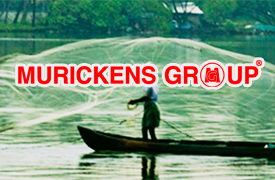
Kerala is situated on the southwest coast of the Indian sub continent with an area of about 38,863 square kilometres, which makes about 1.27% of the Indian territory. The state is separated from the rest of India by the Western Ghats in the east and the Arabian Sea in the west. The territory of Kerala can be divided into three regions, the highlands, midlands and the lowlands. The lowland lies close to the sea. Kerala has a coastline of 589.5 kilometres, which forms 10% of India’s total coastline and this has facilitated trade with other countries since a very long time. The density of population is very high all along the coastline as compared to the midlands and the highlands (Asia Development Bank, 2003). A very rich marine wealth with a large variety of fish and a highly skilled population of fishermen have made Kerala a leading producer and consumer of fish (Aerthayil, 2000). The high rainfall and a large number of rivers makes the Kerala coast especially fertile for fish. One speciality of the Kerala coast is the mudbanks, known in Malayalam as chakara. It is the formation of clay and organic matters on the coast that occurs after monsoon with the sea remaining calm, thus resulting in good harvest of fish. Fish is a source of livelihood and of rich protein for the fishworkers as well as the people of Kerala and fishing plays an important part in the economy of the state .
The district is the major centre of coir and allied products. There are about 4000 production units including a few big factories with mechanized looms. Alappuzha retains monopoly in coir production and exports.
 The turn of the eighties saw exponential growth with exports to the USA, South Africa, the Netherlands, Spain and other European countries. Today a wide variety of coir matting, mats, geotextiles, coir logs, yarns as also products made of jute, sisal, sea grass and other fibers. The leading coir factories are equipped with looms to make matting of one meter to four meters widths. Finishing centre has shearing, trimming, smoking, stenciling (both dye and paint), and gluing, stitching and webbing facilities. The highly-skilled craftsmen who can be relied on to meet exacting specifications is processing the coir works. Personalized attention to detail, realistic prices and prompt shipment, apart from stead fast quality, are what makes us stand apart - and win loyal clients.
The turn of the eighties saw exponential growth with exports to the USA, South Africa, the Netherlands, Spain and other European countries. Today a wide variety of coir matting, mats, geotextiles, coir logs, yarns as also products made of jute, sisal, sea grass and other fibers. The leading coir factories are equipped with looms to make matting of one meter to four meters widths. Finishing centre has shearing, trimming, smoking, stenciling (both dye and paint), and gluing, stitching and webbing facilities. The highly-skilled craftsmen who can be relied on to meet exacting specifications is processing the coir works. Personalized attention to detail, realistic prices and prompt shipment, apart from stead fast quality, are what makes us stand apart - and win loyal clients.
Coir or coconut fibre, is a natural fibre extracted from the outer husk of coconut and used in products such as floor mats, doormats, brushes and mattresses. Coir is the fibrous material found between the hard, internal shell and the outer coat of a coconut. Other uses of brown coir (made from ripe coconut) are in upholstery padding, sacking and horticulture. White coir, harvested from unripe coconuts, is used for making finer brushes, string, rope and fishing nets.It has the advantage of not sinking, so can be used in long lengths on deep water without the added weight dragging down boats and buoys.
Amabalappuzha Sreekrishna Temple on the Kollam-Alappuzha Highway is called the Dwaraka of the South. It is frequented by thousands of devotees especially during the annual festival which falls in April every year.
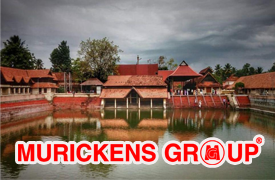 'Ambalappuzha palpayasam' the devotional delicacy of the temple, is renowned for its unique taste. Ambalappuzha is also famous for the traditional visual martial art of Kerala, Velakali. Ambalappuzha Sri Krishna Temple is a Hindu temple in Ambalappuzha, Alapuzha district of Kerala, India.
The Ambalappuzha Sri Krishna Temple is believed to have been built during 17th century AD by the local ruler Chembakasserry Pooradam Thirunal-Devanarayanan Thampuran.
The idol at Ambalapuzha is likened to Parthasarthi form of Vishnu, holding a whip in his right hand and a conch in his left. During the raids of Tipu Sultan in 1789, the idol of Sri Krishna from the Guruvayoor Temple was brought to the Ambalappuzha Temple for safe keeping for 12 years.
Payasam, a sweet pudding made of rice and milk is served in the temple and is believed that the Lord Guruvayoorappan visits the temple daily to accept the offering.
'Ambalappuzha palpayasam' the devotional delicacy of the temple, is renowned for its unique taste. Ambalappuzha is also famous for the traditional visual martial art of Kerala, Velakali. Ambalappuzha Sri Krishna Temple is a Hindu temple in Ambalappuzha, Alapuzha district of Kerala, India.
The Ambalappuzha Sri Krishna Temple is believed to have been built during 17th century AD by the local ruler Chembakasserry Pooradam Thirunal-Devanarayanan Thampuran.
The idol at Ambalapuzha is likened to Parthasarthi form of Vishnu, holding a whip in his right hand and a conch in his left. During the raids of Tipu Sultan in 1789, the idol of Sri Krishna from the Guruvayoor Temple was brought to the Ambalappuzha Temple for safe keeping for 12 years.
Payasam, a sweet pudding made of rice and milk is served in the temple and is believed that the Lord Guruvayoorappan visits the temple daily to accept the offering.
Karumadi, three Kms.from east of Ambalappuzha, has a statue of Buddha called Karumadikuttan, a perennial source of interest for the tourists.
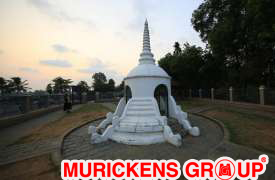
Karumady is a village three km east of Ambalappuzha in Alappuzha district of the Indian state of Kerala. It is famous for Karumady Kuttan, the eleventh century black granite statue of Sri Buddha. The left hand side of this statue is missing.Small crowds can be seen making their way throughout the year to a site located about 5 km east of Ambalappuzha in Alappuzha district. The destination is the Karumadi Kuttan, a renowned Buddhist pilgrim centre, wherein lies a special Buddha statue that dates back to the 11th century. Made of solid black granite, the entire site is today under the protection of Kerala Archaeology Department. People from across the nation and abroad come here to pay homage and seek blessings, as stories about its wonderful healing properties have spread far and wide.Karumadikkuttanis the nickname of a Buddha statue found in Karumady near Alappuzha, Kerala, India.The name literally means boy from Karumady. This 3 feet tall, black granite statue, believed to be old as 9th to 14th century, was abandoned for centuries in a nearby stream named "Karumady thodu". Later in 1930s, Sir Robert Bristow, a colonial British engineer found the statue,[3] and did appropriate actions to protect it. Currently the statue is under the protection of Kerala state government. Left side of the statue is missing. The statue is a subject of historical debate as the reason for its partial destruction is still elusive. Dalai Lama has visited Karumadi in 1965
Arthumkal Church is famous for the St. Sebastian's church which is situated south west of Cherthala town 22 Kms north of Alappuzha. The famous Arthumkal Perunal is held in January in every year. Catholics from all parts of the state participate in the feast of St. Sebastian.
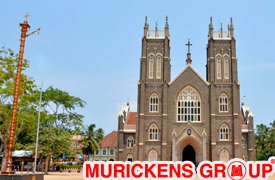
The largest shrine of St Sebastian in the world, the church known as Arthunkal St. Andrew's Basilica and St. Sebastian's International Shrine in Arthunkal, Alappuzha district, Kerala, India, was constructed by Portuguese missionaries in the 16th century.The grand annual feast of St Sebastian Arthunkal in January, which lasts for a month accompanied by millions of pilgrims is one of the important celebrations and major attractions in India.The feast of shrine Basilica also known as makaram perunnal. The church was rebuilt in 1584 under the vicar Jacomo Fenicio, an Italian Jesuit whose devotees claim to possess powers to heal the body and mind. Devotees fondly referred to him as "Arthunkal Veluthachan", "fair skinned father". Fenicio died in 1632. Eight years after his death, the church was rebuilt again, this time reoriented to face west towards the long white-sand beach on the shores of the Arabian Sea. In 1647, a statue of St. Sebastian, struck with arrows all over his bleeding body (he was executed on the order of the Roman emperor Diocletian for embracing the Christian faith) sculptured in Milan, was brought and placed in the Arthunkal church. Arthunkal St Andrews Basilica, the first Parish of the Roman Catholic Diocese of Alleppey was elevated to the status of Basilica on 9 July 2010. Arthunkal Basilica became the first Basilica in the diocese of Alleppey and the seventh basilica in Kerala and the third basilica of the Roman Catholic Latin church of Kerala.
Mannarassala near Harippad 32 Kms. from south of Alappuzha is an important centre of pilgrimage in the district. The famous Mannarassala temple devoted to the serpent deity is a rare phenomenon of worship. The Ayilyam festival held in November in every year is very famous
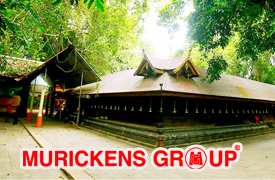
Mannarasala Sree Nagaraja Temple in Haripad is a very ancient and internationally known centre of pilgrimage for the devotees of serpent gods (Nagaraja). The famous Nagaraja temple "Mannarasala" in Haripad is nestled in a forest glade, like most snake temples. The Mannarasala Temple has over 100,000 images of snakes along the paths and among the trees, and is the largest such temple in Kerala. Women seeking fertility come to worship here, and upon the birth of their child come to hold thanksgiving ceremonies here, often bringing new snake images as offerings. A special turmeric paste which is available at the temple is credited with curative powers.Though the legends related to the origin of a place cannot be deemed as its history, the story on the evolution of Mannarasala as one of the foremost places of worship of the Serpent Gods is associated with Lord Parashurama who is widely believed to be the creator of Kerala. This history of Mannarasala has been mentioned in the 'Mandara Salodyam', a Sanskrit poem written by Mannarasala M.G. Narayanan Namboothiri of the sacred family based on the accounts and legends handed down and old scriptures and books available with the temple.
Edathua Church is a gigantic shrine situated on the banks of river Pampa about 24 km from Alappuzha, on the Alappuzha - Thiruvalla Road. The church dedicated to St. George, was built in 1810, and styled on the medieval churches of Europe.
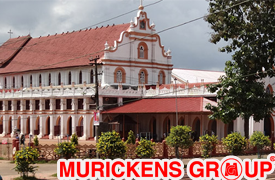 It is believed that prayers and offerings at this church help to recover from mental imbalances and other diseases. Theannual feast is celebrated from April 27th to7th of May (Malayalam month of Medam) and pilgrims from all parts of South India, irrespective of caste and creed, visit the church and seek the blessings of the saint. Although the festival lasts for 11 days, the major festival will be celebrated only would held on all days of the festival, in Tamil and Malayalam. on the last few days before the feast day on the 6th of May. The holy mass and novena.Edathua is a small village in Kuttanad, Alappuzha district, Kerala, India
St. George Forane Church is the major pilgrim centre present here.St.George Forane Church, Edathua is the major pilgrim centre of the area. Feast of St. George which is major festival. People from places including Tamil Nadu, Andhra Pradesh, Telangana attend the feast.Edathua is in the Kuttanad region. It lies below sea level: agricultural land (rice farms) in this region are separated from big and small rivers by high mud levees (bunds called Puravaramp). Farmers and agricultural workers build their dwellings on reclaimed land by expanding upon these levees around these paddy fields known as padam. These levees are also often planted with coconut trees, a major commercial crop in the region. The area attracts a lot of foreign tourists.
It is believed that prayers and offerings at this church help to recover from mental imbalances and other diseases. Theannual feast is celebrated from April 27th to7th of May (Malayalam month of Medam) and pilgrims from all parts of South India, irrespective of caste and creed, visit the church and seek the blessings of the saint. Although the festival lasts for 11 days, the major festival will be celebrated only would held on all days of the festival, in Tamil and Malayalam. on the last few days before the feast day on the 6th of May. The holy mass and novena.Edathua is a small village in Kuttanad, Alappuzha district, Kerala, India
St. George Forane Church is the major pilgrim centre present here.St.George Forane Church, Edathua is the major pilgrim centre of the area. Feast of St. George which is major festival. People from places including Tamil Nadu, Andhra Pradesh, Telangana attend the feast.Edathua is in the Kuttanad region. It lies below sea level: agricultural land (rice farms) in this region are separated from big and small rivers by high mud levees (bunds called Puravaramp). Farmers and agricultural workers build their dwellings on reclaimed land by expanding upon these levees around these paddy fields known as padam. These levees are also often planted with coconut trees, a major commercial crop in the region. The area attracts a lot of foreign tourists.
A festival in Kerala calls for men to disguise as women and carry lamps as a prayer offering to Bhagavathy (Devi) at Kottankulangara temple in Chavara near Kollam in Kerala. 'Kottankulangara Chamayavillaku', the unique festival is celebrated for 19 long days during March -April every year. Men clad in female attires like sarees, churidars and skirts along with make up gather at the temple,
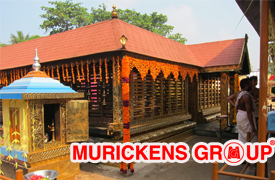 holding a lamp with five lights on a long wooden rod. The practice is expressed as a grateful gesture for blessings bestowed through wishes gratified and also to seek the grace of the Goddess. Trisha a participant in the festival said: "This is the first time that I have come here. I was facing some problems -job problems, study problems, but I got the opportunity now. I am very comfortable here, it's very nice. My friends are also very happy. The atmosphere is very inspiring...this is beyond our imagination," said a jubilant Trisha, a participant in the local festivities.
holding a lamp with five lights on a long wooden rod. The practice is expressed as a grateful gesture for blessings bestowed through wishes gratified and also to seek the grace of the Goddess. Trisha a participant in the festival said: "This is the first time that I have come here. I was facing some problems -job problems, study problems, but I got the opportunity now. I am very comfortable here, it's very nice. My friends are also very happy. The atmosphere is very inspiring...this is beyond our imagination," said a jubilant Trisha, a participant in the local festivities.
"Men clad in female attires like sarees, churidars and skirts along with make up gather at the temple, holding a lamp with five lights". There are many beliefs that talk about the stories involved with the temple and the unique worship. The most popular one is that a group of cowherds dressed as girls, offered flowers and a dish called 'kottan' made of coconut to a stone playfully. It is believed that Goddess Bhagavathy materialized herself before one of the boys subsequently which marked the origin of this peculiar ritual. The local residents believe that the stone is growing in size with the lapse of time. The worship probably denotes the camouflaged fact of the same unifying essence in everyone irrespective of sex difference
A unique back water spot accessible only by boat is 'PATHIRAMANAL'a lonely island in the middle of Vembanad lake, ideal for the honeymooners and the tourists.It is around 1 ½ hours by motor boat/30 min. by speed boat away from Alappuzha. Tourists come here in search tropical scenery and a change from the din of city life and Pathiramanal can provide all kinds of happiness in plenty.

According to mythology a young Brahmin dived into the Vemabanad Lake to perform his evening ablutions and the water made way for land to rise from below, thus created the enchanting island of Pathiramanal (sands of midnight).This little island on the backwater is a favorite haunt of hundreds of rare migratory birds from different part of the world. The island lies between Thaneermukkom and Kumarakom, and is accessible only by boat from Kumarakom and Muhamma in Alappuzha.Pathiramanal is a small island in[3]Muhamma panchayat of Alappuzha district . The name Pathiramanal means 'midnight sand'. The scenic beauty of both sides of the lake as well as that of the island is mind blowing. It is home to many rare varieties of migratory birds from different parts of the world.
MURICKENS GROUP
HO : KOTTAYAM-KADUTHURUTHY
BR : KOTTAYAM- CEMENT JUNCTION
ERNAKULAM-PALARIVATTAM
Real estate cunsulting officials at U.S.A. (Texas & Newyork) & Bombay
Email : mg@murickens.com, murickans@gmail.com